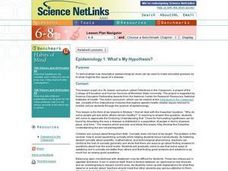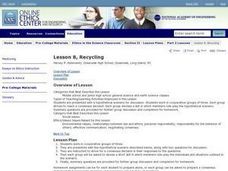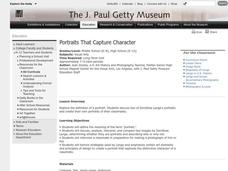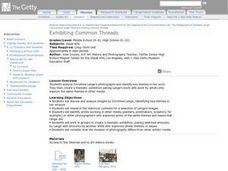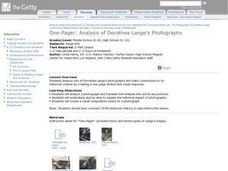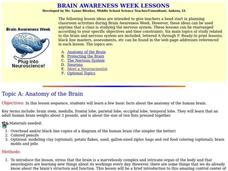Curated OER
Epidemiology 1: What's My Hypothesis?
Students demonstrate how descriptive epidemiological clues can be used to make educated guesses as to what might be the cause of a disease.
Curated OER
Look At Those Leaves!
Students observe leaves and their attributes and group them accordingly. In this science observation instructional activity students gather leaves and use them to become more familiar with seasonal changes and the cycles of our...
Curated OER
Brain Awareness Week
Students explore human anatomy by completing a list of activities over five days. In this brain science lessons, students examine images of brains and identify the different parts. Students complete an in-class quiz regarding brain...
Curated OER
The Autobiography of . . . Me
Students examine the accomplishments of African Americans. After being introduced to the characteristics of an autobiography, they create a timeline of their lives. They use those events to write their own autobiography to share with...
Curated OER
Sampling Snoops
Learners practice formulating a hypothesis and designing an experiment to test the hypothesis. They identify several sampling techniques they can use to test their hypotheses.
Curated OER
Lesson 8, Recycling
Young scholars examine recycling. In this environmental stewardship instructional activity, students practice persuading others to recycle as they collaborate to prepare small group skits. Young scholars discuss the issue and write...
Curated OER
What Makes A Good Speaker?
Students write a response to a diagnostic assessment determining what they need to work on to become good public speakers. They listen to the Dr. Martin Luther King Jr. speech, I Have A Dream, and identify what makes a good speaker.
Curated OER
Space Science:Wherever You Go, There You Are
Students explore navigation principles by observing, measuring, and interpreting data to determine locations. Using a compass, compass rose, and a transit, they plot courses and discover the workings of the Global Positioning System...
Curated OER
Portraits That Capture Character
Students analyze two of Dorothea Lange's portraits and create their own portraits of classmates. In this portrait analysis lesson, students define portrait and discuss two images of Lange's. Students interview a classmate and use Lange's...
Curated OER
Dorothea Lange and the Relocation of Japaneses Americans
Pupils analyze Dorothea Lange's photographs about Japanese American relocation. In this art and history lesson, students analyze a photograph about the relocation of Japanese Americans. Pupils discuss the impact of governmental decisions...
Curated OER
Exhibiting Common Threads
Students analyze Dorothea Lange's photographs and identify key themes in her work. For this photograph analysis lesson, students discuss and analyze the images of Lange and identify her themes. Students research the historical contexts...
Curated OER
So You Want to Be a TV Reporter!
Students work in pairs to interview each other. They identify interviewing skills and methods, conduct a preliminary interview, develop a working script from the notes and participate in a final interview for the camera.
Curated OER
Genes, Environments, and Behavior 2
Students explore how scientists study the genetic and environmental factors that interact to produce variation in behavior across a population.
Curated OER
Making an Electromagnet
Students explore electromagnetic forces. In this electromagnetic lesson, students construct a working electromagnet and conduct a series of experiments to see what increases the strength of an electromagnet.
Curated OER
Analysis of Dorothea Lange's Photographs
Students analyze a photo of Dorothea Lange and make connections to its historical context by creating a written and visual response. For this photograph analysis lesson, students analyze Lange's photograph and explain the historical...
Curated OER
Going to the Promised Land (Dust Bowl Migration)
Students examine Dust Bowl migration. In this Great Depression lesson, students research primary sources regarding migration issues in the United States during the Great Depression. Students discuss their research findings and impressions.
Curated OER
Picturing a Story: Photo Essay About a Community, Event, or Issue
Students research Dorothea Lange's documentary projects and create their own photo essay about a subject. In this photo essay lesson, students analyze examples of social-documentary photographs of Lange. Students define a social...
Curated OER
Trade Wars: the Candidates Take a Stand
Students research topics related to trade, and develop a graphic organizer. They debate and discuss topics related to trade.
Curated OER
Who Needs a Dress Code?
Learners create a poster showing examples of appropriate and inappropriate student grooming and attire. They write comments explaining the need for each rule.
Curated OER
Tasty Tech Activity With Excel
Students are introduce to basic Excel skills, rank their opinions of menu items from fast food restaurants, add their answers to the spreadsheet, and then create a simple graph of the results.
Curated OER
Newsworthy Images
Learners examine images from newspapers, the photo cropping process, and create their own photos to tell a story. In this photography analysis lesson, students analyze a photograph using the elements of art and analyze their own...
Curated OER
CAN'T TOUCH THIS!
Pupils discover the best practical shielding material when dealing with radioactive substances. They draw conclusions based on availability of materials, price, and best shielding properties.
Curated OER
Anatomy of the Brain
Students explore human anatomy by completing a quiz. For this brain lesson, students read assigned text which discusses the different elements of the human brain and how they are used in everyday experiences. Students answer a multiple...
Curated OER
Brain Awareness Week
Students explore the brain. For this science lesson, students create a model of the brain and discuss steps taken in order to protect the brain. Students design a container that would protect the brain from injury. Students discuss the...


